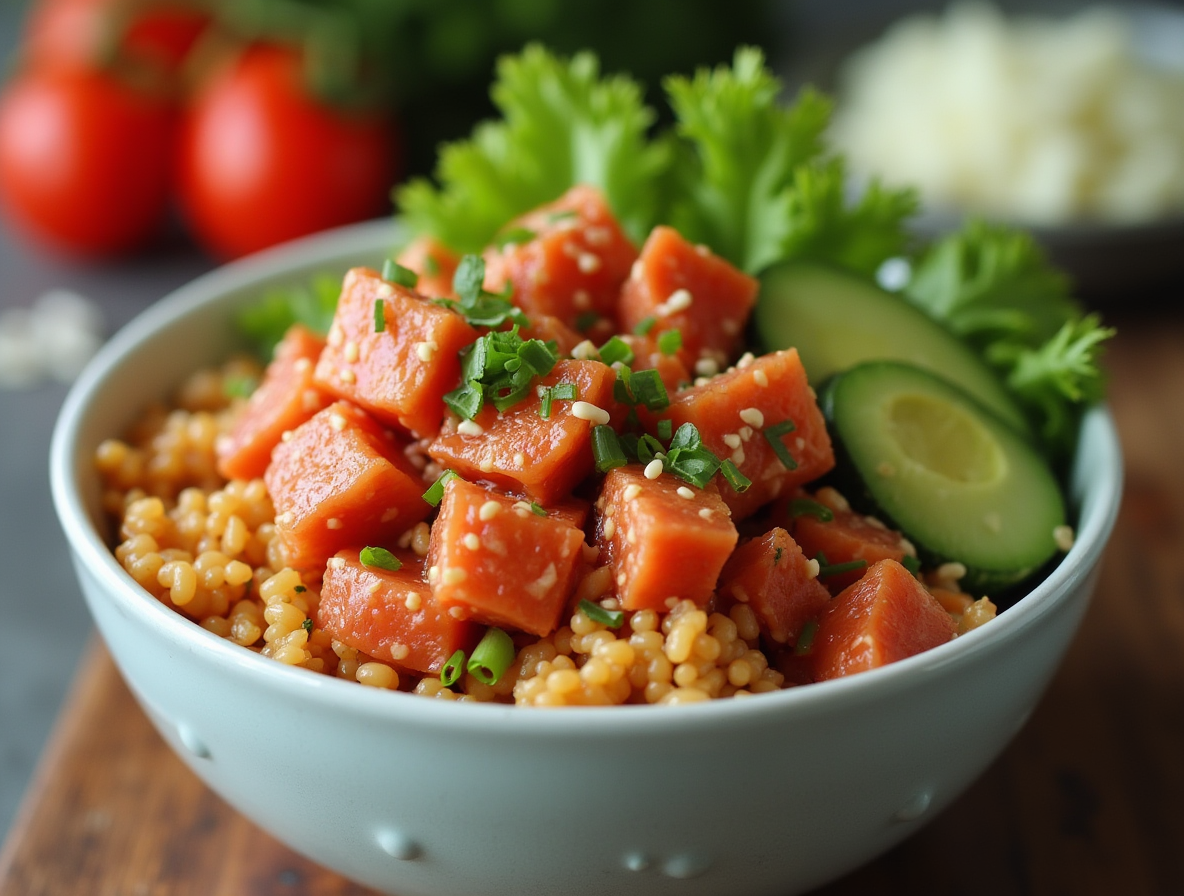How to Make the Perfect Spicy Tuna Poke Bowl (Better Than Takeout!)
Spicy tuna poke bowl preparation takes just 10 minutes, making it one of the quickest gourmet meals you can create at home. I’ve found that “poke,” which means “cut pieces” in Hawaiian, offers endless customization possibilities with toppings like lettuce, mango, and pineapple. Not only is this dish convenient, but it’s also nutritious—a typical serving contains approximately 397 calories with a balanced mix of carbohydrates, protein, and healthy fats.
Additionally, making your own poke bowl is cost-effective. While the average homemade bowl costs around $33 depending on ingredients, you’ll get restaurant-quality results for less than takeout prices. The key to perfect spicy tuna poke lies in selecting sushi-grade tuna (which should smell fresh and display vibrant color) and creating that signature spicy mayo sauce—easily made with just mayonnaise and sriracha. In this guide, I’ll share my step-by-step process for creating a spicy tuna poke bowl that’s truly better than takeout, along with essential ingredients and expert tips to elevate your homemade version.
What is a spicy tuna poke bowl?
A traditional Hawaiian delicacy with a modern twist, the spicy tuna poke bowl has become an international culinary sensation. The word “poke” (pronounced poh-kay) literally means “to slice” or “cut crosswise into pieces” in Hawaiian, reflecting how the fish is prepared before serving.
Origins of poke in Hawaiian cuisine
Poke traces its roots back to ancient Hawaii, where indigenous Polynesians first prepared this dish centuries before Western travelers arrived. Initially, native Hawaiians made simple versions using freshly caught reef fish, seasoned with sea salt, seaweed (limu), and sometimes crushed candlenut (kukui).
Historically, poke began as cut-offs from the day’s catch, served as a quick snack for fishermen. Fresh fish was eaten immediately with sea salt and occasionally seasoned with blood from the gills. A typical traditional relish consisted of inamona (a condiment made from roasted kukui nuts) mixed with dried octopus inksac (ʻalaʻala), fish liver (ake), and salt, usually accompanied by seaweed and poi.
The dish we recognize today evolved significantly over time. According to food historian Rachel Laudan, the present form of poke gained popularity around the 1970s. However, until the 1990s, poke made at home or found at seafood counters was typically limited to just one or two flavors: onion or limu.
Why spicy tuna is a popular variation
The spicy tuna variation emerged as part of poke’s evolution through multicultural influences. During the 19th century, as more advanced fishing fleets entered the Pacific and Japanese workers arrived in Hawaii, the predominant fish used shifted from reef fish to deepwater fish, particularly ahi tuna.
Notably, the most common flavor profile today is soy sauce and sesame oil, with additions of Maui onions, scallions, and ogo seaweed. “Spicy ahi” has become particularly popular, featuring a creamy, spicy mayo base. This fiery kick transforms the classic dish into something new while preserving its essence.
Furthermore, spicy tuna poke has grown in popularity because it balances heat with fresh ingredients. The spicy marinade enhances the richness of the tuna while creating a bold flavor profile that spice lovers find irresistible. The combination with ingredients like avocado, cucumber, and jalapeños creates an explosion of complementary flavors.
Among consumers who have tried poke, 29% love it and an additional 36% like it, with the spicy variation being particularly appealing to those seeking more intense flavors. The dish’s versatility, nutritional value, and unique fusion of cultural influences have cemented its place in modern cuisine.
Essential poke bowl ingredients
Creating a perfect spicy tuna poke bowl at home requires four essential components working in harmony. Each element plays a crucial role in delivering that authentic experience, balancing flavors and textures for a meal that rivals any restaurant version.
Base: rice, greens, or noodles
The foundation of your poke bowl provides both substance and subtle flavor. Most traditionally, short-grain sushi rice forms the base, offering that distinctive sticky texture that holds together nicely. Nevertheless, you have several alternatives:
- Brown rice offers higher fiber content (three times more than leafy greens) and additional protein
- White rice contains less sodium and more calcium and iron than brown rice
- Quinoa provides a protein-rich alternative
- Leafy greens create a lighter, lower-carb option with only 1 gram of carbs per serving compared to rice’s 45 grams
- Soba or rice noodles offer an interesting textural alternative
For a balanced approach, consider a half-rice, half-greens combination to keep carbs in check while maintaining satisfaction.
Protein: sushi-grade tuna and alternatives
The centerpiece of any spicy tuna poke bowl must be sushi-grade (also called sashimi-grade) tuna. When selecting tuna:
Look for bright, vibrant reddish hues with flesh that isn’t watery, mushy, or slimy. The fish should spring back when gently pressed and have no fishy odor. Specifically, ahi tuna (either bigeye or yellowfin) works best due to its rich flavor, natural umami, and firm flesh.
If raw tuna isn’t your preference, consider these alternatives:
- Raw or seared salmon (higher in omega-3s and vitamin B-12 than tuna)
- Cooked shrimp or octopus
- Tofu (providing 10 grams of protein per serving plus iron, magnesium, zinc, and vitamin B)
Toppings: avocado, cucumber, seaweed, and more
Toppings add crucial texture, flavor, and nutritional value. Popular choices include:
Avocado – contributes healthy fats and magnesium Cucumber – provides freshness and crunch, considered “non-negotiable” by many chefs Seaweed/nori – supports thyroid health with iodine and tyrosine Edamame – adds plant protein Mango or pineapple – offers tropical sweetness Green onions – provides sharp flavor contrast
Sauces: spicy mayo, soy-based dressings
The sauce ties everything together, with two primary options dominating:
Spicy mayo – mix 1-3 teaspoons sriracha with 3 tablespoons mayo, then add a touch of lime juice for brightness. Some versions include a small amount of honey and soy sauce to balance heat.
Soy-based dressing – typically combines soy sauce, rice vinegar, and sesame oil. This classic option works especially well with tuna.
For a more complex flavor profile, consider ponzu sauce, gochujang, or teriyaki as alternatives to complement your chosen protein and toppings.
How to make spicy tuna poke step-by-step
Let’s dive into the step-by-step process of crafting your own restaurant-quality spicy tuna poke bowl at home. Following these simple instructions will yield a meal that rivals any takeout version.
1. Prepare the rice or base
First, rinse your short-grain sushi rice thoroughly under cold water until it runs clear, removing excess starch. For proper cooking, combine 2 cups of rice with 2½ cups of water in a pot. Bring to a boil, reduce heat, cover, and simmer for 12-15 minutes. Afterward, remove from heat and let it rest covered for another 10-15 minutes.
Meanwhile, prepare your sushi vinegar by mixing ¼ cup rice vinegar with 2 teaspoons sugar and ¼ teaspoon salt until dissolved. Once the rice has rested, transfer it to a large, shallow dish and drizzle this mixture evenly over the top. Gently fold with a cutting motion to coat all grains. To prevent drying, cover with a damp cloth while it cools to room temperature.
2. Make the spicy tuna poke mixture
Pat your sushi-grade tuna dry with paper towels to remove excess moisture. Using your sharpest knife, cut the tuna into ¼-inch cubes. In a mixing bowl, combine 2 tablespoons Japanese Kewpie mayonnaise, 1 teaspoon sesame oil, 1 teaspoon sriracha (adjust to taste), and 2-3 teaspoons soy sauce. Gently fold in the tuna pieces until evenly coated. For best results, let this mixture marinate for at least 15-20 minutes, though no longer than an hour to maintain optimal texture.
3. Chop and prep toppings
Simultaneously, prepare your toppings: dice cucumber into ½-inch cubes, slice avocado, shred carrots, and thinly slice green onions. For added texture, consider steaming edamame or preparing a quick cucumber salad by tossing cucumber slices with rice vinegar and a touch of honey. Keep all toppings separate until assembly time.
4. Assemble the bowl
Start by placing a generous scoop of your prepared rice in the bottom of each bowl. Around the perimeter, arrange your prepped vegetables in small, colorful sections. The visual appeal comes from thoughtful arrangement—consider alternating colors for maximum visual impact. Leave space in the center for your marinated tuna mixture.
5. Drizzle with sauce and serve
Finally, place your marinated tuna in the center of each bowl. For extra flavor, prepare spicy mayo by mixing 2 tablespoons mayo with 2 teaspoons sriracha, thinning with a little water if needed for drizzling. Generously drizzle this sauce over the entire bowl. Garnish with sesame seeds, additional green onions, or nori strips if desired. Serve immediately for the freshest experience.
Tips to make it better than takeout
The difference between ordinary and extraordinary spicy tuna poke bowls often comes down to a few expert techniques. With these insider tips, your homemade creation will surpass even the best takeout versions.
How to buy sushi-grade tuna safely
The foundation of exceptional poke begins with selecting proper fish. First, understand that “sushi-grade” isn’t officially regulated by the FDA. Instead, look for tuna with vibrant, clean color without glowing, plastic-like redness that indicates chemical treatment. The flesh should spring back when gently pressed and have no fishy odor.
For optimal safety, purchase from reputable fishmongers who specifically sell fish for raw consumption. Certainly ask whether the fish has been previously frozen at low temperatures, as this helps eliminate potential parasites. Indeed, properly frozen fish is actually preferred for raw applications.
Balancing flavors and textures
Creating restaurant-quality poke requires hitting at least three textural categories. Consider including something creamy (avocado), crunchy (cucumber or fried shallots), and chewy (seaweed) in each bowl.
Moreover, match the fish intensity to your sauce—fattier, firmer fish like tuna can handle bolder seasonings, whereas delicate fish need simpler dressings. For depth, incorporate elements from different flavor profiles: salty (soy sauce), spicy (sriracha), sweet (mango), and umami (sesame oil).
Creative topping ideas
Elevate your bowl with these unexpected additions:
- Allium variations: Garlic chips, fried shallots, or finely chopped sweet onion
- Heat elements: Crushed wasabi peas, thinly sliced Fresno chiles, or jalapeños
- Crunchy components: Macadamia nuts, skin-on roasted peanuts, wonton chips
- Pickled elements: Ginger, shiitake mushrooms, red onions
Subsequently, finish with furikake (Japanese rice seasoning) for an umami boost.
Storage and freshness tips
Given the raw nature of poke, freshness is paramount. Store in an airtight container in the coldest part of your refrigerator (below 40°F). Importantly, consume within two days of preparation, though same-day consumption is ideal.
Never leave poke at room temperature for more than two hours (or one hour if temperatures exceed 90°F). Watch for spoilage signs including fishy or ammonia-like odors, dull coloration, or slimy texture. Hence, when in doubt, throw it out rather than risking foodborne illness.
Conclusion
Throughout this guide, we’ve explored every aspect of crafting the perfect spicy tuna poke bowl at home. Undoubtedly, this Hawaiian-inspired dish offers a delightful balance of flavors, textures, and nutrients that rivals any restaurant version. Making your own poke bowl provides complete control over ingredients while costing significantly less than takeout options.
Safety remains paramount when working with raw fish. Therefore, purchasing high-quality, sushi-grade tuna from reputable sources ensures both flavor and food safety. The foundation of rice, coupled with fresh vegetables and that signature spicy mayo sauce, creates a harmonious meal that satisfies both nutritional needs and culinary desires.
Additionally, customization stands as one of the greatest advantages of homemade poke. Your preferences dictate everything – from the level of spiciness to the variety of toppings. This flexibility allows everyone to create their ideal bowl, whether you prefer traditional Hawaiian flavors or contemporary fusion variations.
Freshness, likewise, plays a crucial role in exceptional poke. Consuming your creation soon after preparation guarantees the best texture and flavor profile. Though poke bowls require minimal cooking time, they deliver maximum satisfaction and impressive results that will have you questioning why you ever ordered takeout.
Last but certainly not least, the cultural appreciation gained through understanding poke’s rich Hawaiian heritage adds another dimension to your dining experience. Each bite connects you to centuries of culinary tradition, albeit with modern twists that keep this dish relevant and exciting.
Next time you crave a spicy tuna poke bowl, skip the delivery app and head to your kitchen instead. Armed with these techniques and tips, you’ll create a dish that’s fresher, more economical, and perfectly tailored to your taste buds – truly better than any takeout version could ever be.
FAQs
Q1. What are the key ingredients for a spicy tuna poke bowl? A spicy tuna poke bowl typically includes sushi-grade tuna, sushi rice, spicy mayo sauce, and various toppings such as avocado, cucumber, seaweed, and green onions. The tuna is usually marinated in a mixture of soy sauce, sesame oil, and sriracha for added flavor and heat.
Q2. Is a spicy tuna poke bowl a healthy meal option? Yes, a spicy tuna poke bowl can be a healthy meal choice. It’s high in protein from the tuna, contains essential nutrients, and includes fresh vegetables. However, the overall healthiness depends on portion sizes and the specific ingredients used, particularly in sauces and toppings.
Q3. How do you ensure food safety when preparing raw tuna for poke? To ensure food safety, always purchase sushi-grade tuna from reputable sources. Look for tuna with a vibrant color and firm texture. It’s best to consume the poke bowl immediately after preparation, and never leave it at room temperature for more than two hours. Store any leftovers in the refrigerator and consume within two days.
Q4. Can I customize my spicy tuna poke bowl? Absolutely! Poke bowls are highly customizable. You can adjust the spice level of the sauce, choose different bases like brown rice or greens, and add various toppings such as edamame, mango, or macadamia nuts. You can even substitute the tuna with other proteins like salmon or tofu.
Q5. How long does it take to make a spicy tuna poke bowl at home? Preparing a spicy tuna poke bowl at home typically takes about 20-30 minutes. This includes time for cooking the rice, marinating the tuna, and preparing the toppings. The actual assembly of the bowl is quick, making it an excellent option for a fast, gourmet-style meal.


